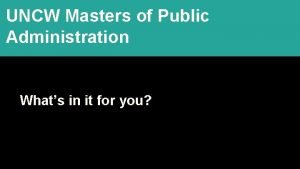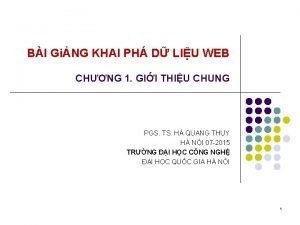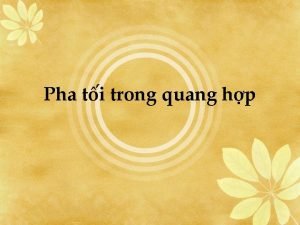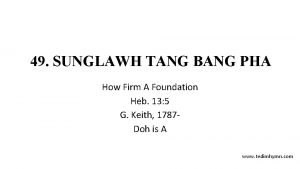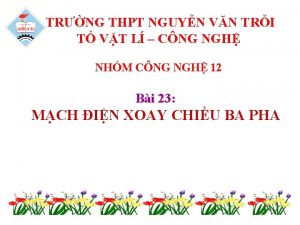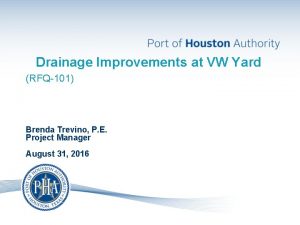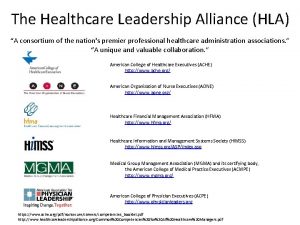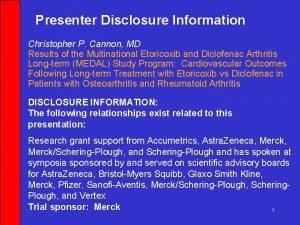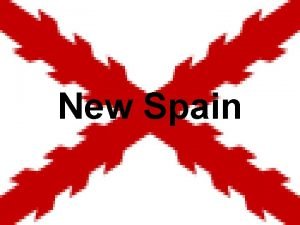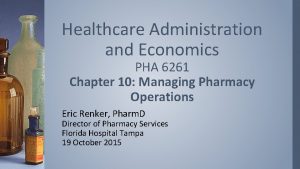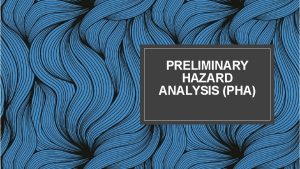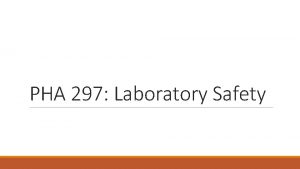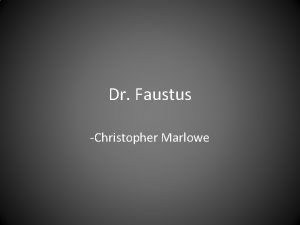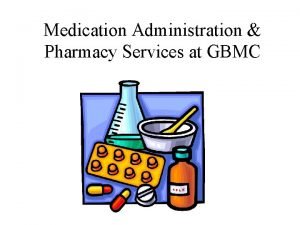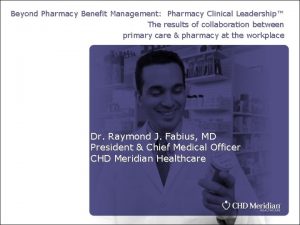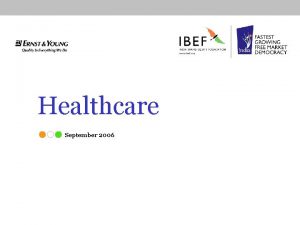Healthcare Administration Economics PHA 6261 Pharmacy Leadership Christopher




































- Slides: 36

Healthcare Administration & Economics PHA 6261 Pharmacy Leadership Christopher Lynch, Pharm. D, MEd CDR, MSC, USN (ret)

Pharmacy Leadership & Management in Pharmacy Practice, 2 nd ed Principles & Characteristics of Leadership (Ch. 1) Understanding & Working in the Organization (Ch. 2) The Importance of Vision, Inspiration, & Strategic Planning and Getting it Done (Ch. 3) Leading Culture, People & Strategic Planning (Ch. 4) Leading Change & the Pharmacy Enterprise (Ch. 5)

Pharmacy Leadership Principles & Characteristics of Leadership (Ch. 1) What is the difference between leadership and management? Can you tell the difference?

Pharmacy Leadership “Managers are people who do things right and leaders are people who do the right thing. ” “Managers typically focus on performing the job on behalf of the organization…” “Leaders consider the needs of the organization as well as the needs of the people they are leading. ” “Leaders are not always managers, and managers are not always leaders. ” “Those who display characteristics of both are typically best for organizations. ” (and professions)

Pharmacy Leadership “Leadership, the ability to influence the actions of others, is based on the interaction of three elements: the leader, the person or persons being led, and the situation in which both exist. ”

Pharmacy Leadership The Purpose of leadership: To help individuals, groups, and organizations grow and develop. Individuals – need leaders to help their personal and professional growth Groups – need leadership to promote teamwork, cohesion and reach mutual goals Organizations – need leadership to ensure activities align with collective vision & expectations to achieve desired outcomes

Pharmacy Leadership Theories Leadership has been studied…a lot! Think of people you would consider a leader? What are some traits/characteristics of a leader? Were these traits/characteristics inherent, learned, or both? No single trait/characteristic or combination fully fits

Pharmacy Leadership Theories What separates leaders from followers? Historically, researchers & theorists looked at the task -relationship approach; the situation and relationship interaction of the leader & follower Learnable behaviors were theorized for different situations/environments (Kersey & Blanchard): -Situational -Contingency

Pharmacy Leadership Situational Leadership Leader assumes a role/style based on the situation and the readiness level of the followers Readiness: willingness, confidence, & ability to do a particular task Leadership styles (4) depends on the motivation and functionality of the followers & task complexity: -Telling -Selling -Participating -Delegating

Pharmacy Leadership Situational Leadership Styles Telling – best for inexperienced followers; leader gives direction and encouragement Selling – best for experienced/seasoned followers who require retooling or convincing of a better way Participating – followers have skillset, so leader is more supportive; highly encouraging (coaching) Delegating – followers are willing and able to take responsibility for completing the task(s)

Pharmacy Leadership Situational Leadership Theories Involve the follower’s perception of the task Stress the complexity of the leader-follower relationship Cannot predict what exact leadership/personal skills are needed Only identify how a leader should behave; not what makes a good leader

Pharmacy Leadership Current Leadership Research Situational Theories cannot predict traits of leaders This led to studying the difference between leaders and managers Researchers again looked at personality traits as markers of leadership The strongest predictor of leadership potential is having organizational vision

Pharmacy Leadership Current Leadership Research You MUST have vision to be a leader You also must be able to facilitate a shared vision This is done by valuing human resources (i. e. people); those in your charge People are the most important asset in your charge Theories (2): -Transformation Leadership -Emotional Intelligence

Pharmacy Leadership Transformational Leadership Developed in late 1970’s Not specific behavior, but a process which raises the leader & follower to higher levels of motivation and ethical behavior Driven by a desire for fairness – something better Involves a shared vision & self actualization needs

Pharmacy Leadership Transformational Leadership This style helps build high quality, highly effective teams with strong relationships between leaders and followers (bonds) Leaders facilitate a shared purpose by creating a vision of the future that is attractive to followers; then challenge followers to perform Is usually intellectual and emotional, with questioning of long-standing beliefs and traditions which brings new ideas and commitment/loyalty (ownership vs buy-in)

Pharmacy Leadership Emotional Intelligence Introduced by Daniel Goleman “The ability to recognize one's own and other people's emotions, to discriminate between different feelings and label them appropriately, and to use emotional information to guide thinking and behavior” Emotional needs, drives & true values of a person Largely determines leaders success

Pharmacy Leadership Emotional Intelligence Described in 4 domains: Self-Awareness -recognizing personal emotions & motivations and how they affect others Self-Management -managing emotions (especially disruptive emotions); creates trustworthiness and integrity Social Awareness -sense the emotions of others and empathize (individuals, groups and organizationsclimate) Social Skill (relationship management) -building relationships, developing teams & collaborative groups; managing conflicts; using communication as a tool to influence others

Pharmacy Leadership Emotional Intelligence & Leadership Styles 6 styles developed by Goleman No one style used exclusively; all have some use Affiliative Authoritative Coaching Coercive Democratic Pacesetting Feedback & rewards Self-confidence empathy Team building Delegation Personnel development Demand compliance Participation Consensus Buy-in Autocratic High Standards -Social Awareness -Social Skill -Self -Awareness -Social Skill -Self. Management

Pharmacy Leadership “The need for leadership in pharmacy is growing as the profession expands its horizons and takes on more patient-focused responsibilities. ” “Effective leadership in pharmacy is critical to having an innovative practice setting, and to advancing the practice of pharmacy. ” “The changing nature of pharmacy practice must be led, not just managed. ” “Regardless of a pharmacist’s practice setting, knowledge of the leadership and management skills will aid them in serving the profession throughout their careers. ”

Pharmacy Leadership Do you see yourselves as being leaders in the pharmacy profession, or do you think you’re too young, or it’s not your job? Leadership begins with you! You can’t lead with a bad attitude! Before you can lead others, you must be able to lead yourself. You can’t lead yourself until you know yourself. You can’t lead others until you know them. Leadership is needed at all levels…ENGAGE!

Pharmacy Leadership Leading & Managing Health-Care Professionals Distinct from leading other professionals: -human beings involved -high level of precision -high level of knowledge -stakes are high -quality is essential -high level of skill Basic contribution of Health Professionals is intellectual in nature (it’s all about knowledge!) Meaning of the word “Profession”? Pharmacists “profess” to be medication therapy experts, committed to optimal (quality) outcomes

Pharmacy Leadership Leading & Managing Health-Care Professionals Management is a process in which inputs are transferred by managers into desired outputs Management process is comprised of 5 functions -Covert Leadership -Identifying Influencers -Motivating Professionals -Rewards & Reinforcement -The Importance of Communication Think of functions as individual steps, not in series, but as part of a continual process

Pharmacy Leadership Leading & Managing Health-Care Professionals Covert (Subtle) Leadership -Professionals generally require little direction & supervision -Think of an orchestra conductor (manages the nuances) Identifying Influencers -Influential individuals not in leadership roles -Powerful allies or foes (must get them onboard) Motivating Professionals -Know what appeals to them (top 5 things) -Key to promoting a strong and loyal workforce

Pharmacy Leadership Leading & Managing Health-Care Professionals Rewards & Reinforcement -Different from motivation (external, not internal) -Need for acknowledgment & recognition -Be fair & consistent The Importance of Communication -Knowledge is power, but communication is key! -Key determinant in an organization achieving objectives -Listen, listen!

Pharmacy Leadership When Professionals Become Managers Very few people start out as managers Strong performance in a specialty = management Peter Principle – “in a hierarchy, every person tends to rise to their level of incompetence. ” “the art of management is learned on the job” Relative application of management skills over time

Pharmacy Leadership The Manager’s Role Availability & Accessibility are critical! Listening is great strategy to solve problems Be an advocate for subordinates Be cautious when giving out advice No simple strategies for managing professionals

Pharmacy Leadership Understanding & Working in the Organization (Ch. 2) “The manner in which organizations are put together clearly affects how they function. ” “An organization is a group of individuals structured to work together to achieve common goals. ” “The formal organizational structure is usually depicted by an organizational chart. ”

Pharmacy Leadership Classical Organizational Theory Described by Max Weber in early 1900’s and expanded by Henri Fayol Based on scientific method of analyzing processes & procedures to provide the most efficient means of organizing individuals for maximum productivity 14 Points/Principles of Organization/Management Only focusing on: Specialization of Labor, Unity of Command, and Scalar Chain (of command)

Pharmacy Leadership Specialization of Labor Places individuals into categories based on job functions to increase productivity Common in Pharmacy Practice (i. e. Community, Institutional, Long-term-care, etc. ) Unity of Command & Scalar Chain (of command) Hierarchy (lines) of authority needed for structure and to know who’s the boss Should only be one boss (unity of command)

Pharmacy Leadership Power & Authority Max Weber defined power as, “the possibility of imposing one’s will upon the behavior of others. ” In the context of organizations, “power is the individual’s capacity to move others, to entice others, to persuade and encourage others to attain specific goals or to engage in specific behavior; it is the capacity to influence and motivate others” 5 types of power: -Reward -Expert -Coercive -Legitimate -Referent (charismatic)

Pharmacy Leadership Formal vs. Informal Power Formal - powers of position -Legitimate power is based on one’s position -Reward & Coercive powers are conversely related Informal – personal powers -Expert power is derived from one’s knowledge or expertise -Charismatic power is an interpersonal skillset

Pharmacy Leadership Managing with Power Individuals are reluctant to use their power (especially in Health-Care) Too much time spent in decision-making process (analysis paralysis) Power needs to be used (decisions made) and then time spent adjusting as needed Power & Influence are the tools needed to get things done (leaders must utilize)

Pharmacy Leadership Modern Organizational Theories More managing people (behavior) than processes Theories X, Y, and Z (Douglas Mc. Gregor) Theory X – people inherently dislike work and need to be coerced into performing duties (job security). Theory Y – people want to exercise self-direction/control and accept additional responsibility; job commitment is a function of rewards and not just job security. Theory Z – similar to X & Y, but emphasizes attitudes and behaviors of the worker in which a large amount of trust & responsibility is placed. Success and failures are shared amongst workers and management

Pharmacy Leadership Organization Structure Types Rigid vs. Loose Mechanistic Organizations – traditional, most common, clearly defined lines of authority and tasks, centralized decision making Matrix Organization – dual authority system based on functional (project) and departmental lines (2 managers). Violates unity of command principle Organic Type – (i. e. Multidisciplinary Team), somewhat like bureaucracy (physician leading), but more flexible. The patient (or goal) is the focus. Potential for conflict.

Pharmacy Leadership The C-Suite Group of individuals at the top of the organization CEO, COO, CFO, CIO, Chief of Staff, DNS, (what about pharmacy…CPO? ) Pharmacists must be aware of C-Suite priorities (big picture) and how pharmacy fits in it/can help Must communicate with C-Suite Pharmacy Strategic Plan and Plan-of-Action & Milestones (POA&M)

Pharmacy Leadeship QUESTIONS? sparks 2 scripts@gmail. com 904 -718 -8054 (mobile)
 Ift6261
Ift6261 Ift 6261
Ift 6261 Mandy: “can i help you?” mandy wanted to know
Mandy: “can i help you?” mandy wanted to know Healthcare and the healthcare team chapter 2
Healthcare and the healthcare team chapter 2 Sports medicine meaning
Sports medicine meaning Uncw graduate programs
Uncw graduate programs Uic healthcare administration
Uic healthcare administration Healthcare administration in athletic training
Healthcare administration in athletic training Health administration definition
Health administration definition Pha associates
Pha associates Lược đồ quang trung đại phá quân thanh
Lược đồ quang trung đại phá quân thanh Thiết kế nghiên cứu khám phá
Thiết kế nghiên cứu khám phá Pha chế dung dịch canxi hiđroxit
Pha chế dung dịch canxi hiđroxit Liu web
Liu web Vua nào đại phá quân thanh tơi bời
Vua nào đại phá quân thanh tơi bời Pha ti
Pha ti Heb pha
Heb pha Cách nối nguồn hình sao
Cách nối nguồn hình sao Vw pha
Vw pha Ihi leadership alliance
Ihi leadership alliance Healthcare leadership alliance
Healthcare leadership alliance Va healthcare leadership talent institute
Va healthcare leadership talent institute Maastricht university economics and business economics
Maastricht university economics and business economics Econ213
Econ213 Transformational leader and transactional leader
Transformational leader and transactional leader What is adaptive leadership style
What is adaptive leadership style Enthusiastic beginner disillusioned learner
Enthusiastic beginner disillusioned learner Leiomyosarcoma
Leiomyosarcoma Chris buehler
Chris buehler Christopher hirata
Christopher hirata Cma cgm christopher columbus
Cma cgm christopher columbus Thomas notorious big
Thomas notorious big Gallego serial killer
Gallego serial killer Devion christopher brooks
Devion christopher brooks Christopher p cannon
Christopher p cannon When did christopher columbus discover america
When did christopher columbus discover america Christopher dalley
Christopher dalley





